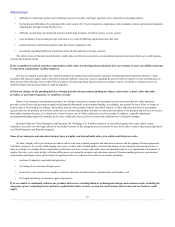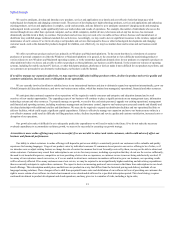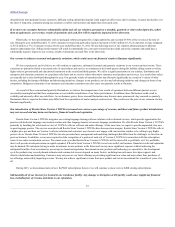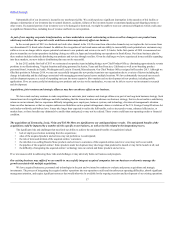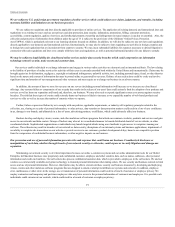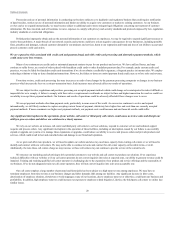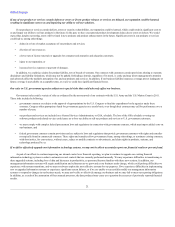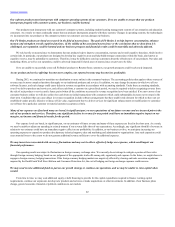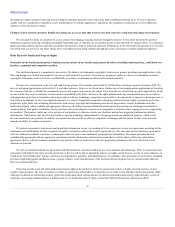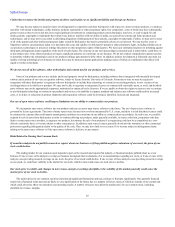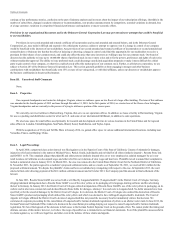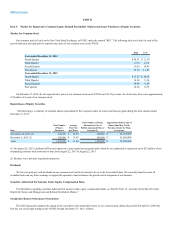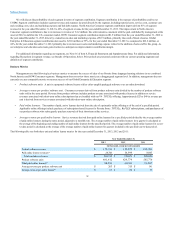Rosetta Stone 2013 Annual Report Download - page 25
Download and view the complete annual report
Please find page 25 of the 2013 Rosetta Stone annual report below. You can navigate through the pages in the report by either clicking on the pages listed below, or by using the keyword search tool below to find specific information within the annual report.
Table of Contents
the market for online commerce may lead to more stringent consumer protection laws, which may impose additional burdens on us. If we are required to
comply with new regulations or legislation or new interpretations of existing regulations or legislation, this compliance could cause us to incur additional
expenses or alter our business model.
Changes in how network operators handle and charge for access to data that travel across their networks could adversely impact our business.
We rely upon the ability of consumers to access certain of our language learning solutions through the Internet. To the extent that network operators
implement usage based pricing, including meaningful bandwidth caps, or otherwise try to monetize access to their networks by data providers, we could incur
greater operating expenses and our subscriber acquisition and retention could be negatively impacted. Furthermore, to the extent network operators were to create
tiers of Internet access service and either charge us for or prohibit us from being available through these tiers, our business could be negatively impacted.
Protection of our intellectual property is limited, and any misuse of our intellectual property by others, including software piracy, could harm our
business, reputation and competitive position.
Our intellectual property is important to our success. We believe our trademarks, copyrights, trade secrets, patents, pending patent applications, trade
dress and designs are valuable and integral to our success and competitive position. To protect our proprietary rights, we rely on a combination of patents,
copyrights, trademarks, trade secret laws, confidentiality procedures, contractual provisions and technical measures.
We have six issued patents in the U.S. and eight foreign patents. This includes patents held by Tell Me More (Auralog) acquired in January 2014. We
have several patent applications on file in the U.S. and other countries. However, we do not know whether any of our pending patent applications will result in
the issuance of patents or whether the examination process will require us to narrow our claims. Even if patents are issued from our patent applications, which
are not certain, they may be contested, circumvented or invalidated in the future. Moreover, the rights granted under any issued patents may not provide us
with proprietary protection or competitive advantages, and, as with any technology, competitors may be able to develop similar or superior technologies now or
in the future. In addition, we have not emphasized patents as a source of significant competitive advantage and have instead sought to primarily protect our
proprietary rights under laws affording protection for trade secrets, copyright and trademark protection of our products, brands, trademarks and other
intellectual property where available and appropriate. However, all of these measures afford only limited protection and may be challenged, invalidated or
circumvented by third parties. In addition, these protections may not be adequate to prevent our competitors or customers from copying or reverse-engineering
our products. Third parties could copy all or portions of our products or otherwise obtain, use, distribute and sell our proprietary information without
authorization. Third parties may also develop similar or superior technology independently by designing around our intellectual property, which would
decrease demand for our products. In addition, our patents may not provide us with any competitive advantages and the patents of others may seriously
impede our ability to conduct our business.
We protect our products, trade secrets and proprietary information, in part, by requiring all of our employees to enter into agreements providing for the
maintenance of confidentiality and the assignment of rights to inventions made by them while employed by us. We also enter into non-disclosure agreements
with our technical consultants, customers, vendors and resellers to protect our confidential and proprietary information. We cannot guarantee that our
confidentiality agreements with our employees, consultants and other third parties will not be breached, that we will be able to effectively enforce these
agreements, that we will have adequate remedies for any breach, or that our trade secrets and other proprietary information will not be disclosed or will
otherwise be protected.
We rely on contractual and license agreements with third parties in connection with their use of our products and technology. There is no guarantee that
such parties will abide by the terms of such agreements or that we will be able to adequately enforce our rights, in part because we rely, in many instances, on
"click-wrap" and "shrink-wrap" licenses, which are not negotiated or signed by individual licensees. Accordingly, some provisions of our licenses, including
provisions protecting against unauthorized use, copying, transfer, resale and disclosure of the licensed software program, may be unenforceable under the
laws of several jurisdictions.
Protection of trade secret and other intellectual property rights in the markets in which we operate and compete is highly uncertain and may involve
complex legal questions. The laws of countries in which we operate may afford little or no protection to our trade secrets and other intellectual property rights.
Although we defend our intellectual property rights and combat unlicensed copying and use of software and intellectual property rights through a variety of
techniques, preventing unauthorized use or infringement of our intellectual property rights is inherently difficult. Despite our enforcement efforts
24


